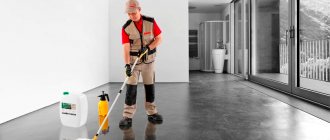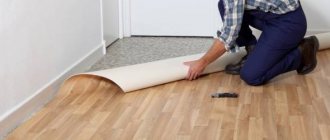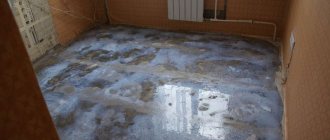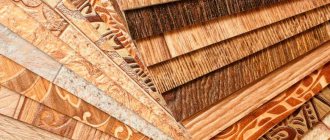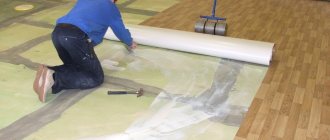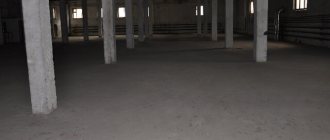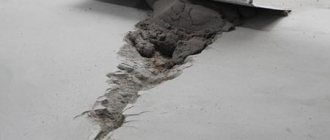Just as wave impacts crumble coastal rocks into sand over the years, constant walking gradually wears away a seemingly monolithic concrete floor, generating cement dust that is completely unacceptable in many areas of activity. This always happens, no matter how high-quality the concrete is - the only difference is the abrasion time and the amount of dust.
If the concrete is of low quality, or the laying technology is violated, the consequences can be much worse - both for the functioning of the equipment and for the body of workers. Especially often, such problems arise in places where heavy loads are handled - warehouses and workshops.
To prevent such unpleasant effects, the concrete floor is dust-free. This is a necessary operation, specified in the safety regulations of any warehouse, and can significantly reduce both the amount of dust and the very possibility of its occurrence.
Dust removal is carried out as follows:
- during the process of laying concrete - in this case no additional coating is provided;
- after laying concrete - immediately or after a certain period of use. In this case, the floor surface is treated with special compounds;
- updated over time under heavy intensive loads - when working in warehouses and large industries.
Allow at least four weeks between pouring the concrete and applying the coating to ensure the strength of the floor and make it easier to saturate the concrete. Otherwise, the entire structure may fall apart, and the only solution will be very labor-intensive dismantling.
Why is dust removal necessary?
Dust on a concrete base is caused by erosion of the material. First, the upper layers are subjected to this process, then the lower ones, and then not far from the destruction of the structure itself. In addition, concrete dust itself is harmful to humans. It causes diseases such as allergies, asthma and others similar to them.
But that's not all. Strong dust clogs the equipment, causing rapid abrasion of rotating parts and assemblies. The floor itself loses its original appearance due to dust, making the room less attractive in terms of aesthetics. Here you can add constant and frequent cleaning, and not only of the floor base, but of ceiling and wall surfaces. That is, concrete dust is a big problem. Therefore, dust removal from concrete is a necessary process, regardless of whether such a floor is the main base in the room or is a surface for further cladding.
Concrete dust is very harmful Source userapi.com
The best anti-dust products: review
There are a huge number of drugs on the market, positioned by manufacturers as salvation from dust. In fact, in order to choose a product that really works, you need to know about some nuances, for example, be able to familiarize yourself with the composition and, most importantly, the purpose.
Not every dust remover is universal; moreover, the vast majority are designed for specific surfaces. Neglecting the rule of selection taking into account compatibility will have the opposite effect - dust will appear even faster and in greater quantities.
There are such options for means to combat dust deposits:
- polishes;
- antistatic agents;
- sprays;
- impregnation.
Polish is an excellent remedy for removing dust from furniture, but nothing more. The composition of the preparations includes special degreasing components, as well as antistatic agents and antiseptics. After treatment with polishes, the furniture surface becomes shiny, clean and, most importantly, more resistant to dust formation.
Antistatic agents are suitable for processing electronic and household appliances. They are used to wipe computers, laptops, and televisions. Contains components that successfully repel dust and dirt from static surfaces. Particularly effective when combined with special microfiber cloths.
But a dust spray is one of the few universal products that can destroy dust mites, minimize static and reduce the amount of allergens in the air. Due to increased activity, it is recommended to use sprays no more than once every six months. All surfaces in the room must be treated, including:
- clothes;
- curtains;
- carpets;
- upholstered furniture;
- wallpaper;
- soft toys, etc.
Impregnations for upholstered furniture are specially designed to clean and protect items from dust. Their use is characterized by the formation of a special film that prevents the formation of dust deposits. For the product to work, manufacturers recommend cleaning furniture every few months.
Materials and technologies
In fact, the dust removal process affects the top layer of the concrete floor. The main task here is to strengthen this layer or cover it with compounds that would be strong and wear-resistant. That is, they could withstand serious loads on them for a long time.
But before carrying out the process itself, it is necessary to prepare the concrete floor.
- The surface is polished using a concrete grinding machine with diamond discs. The device itself is equipped with a dust extractor and a collector for dust and dirt.
- Any, even the newest concrete floor, has defects that need to be covered. For this purpose, special polymer compositions are used today. One of the most popular is epoxy resin with quartz fine-grained sand.
- The concrete base is primed. Optimally - deep penetration primers that bind concrete particles together, thereby strengthening its top layer.
Now about the materials. There are several formulations that are used today. These are the so-called fluates, various impregnations and paints.
Impregnations for concrete bases Source prom.st
Fluats
It should be noted that these substances are not essential for protection. This is an auxiliary material that is applied before painting the concrete floor. But it performs its purpose, namely dust removal, efficiently.
Fluate is a substance of inorganic origin. Essentially, it is a glassy substance, namely silicon dioxide. When applied to the surface of concrete, this material covers it with a durable film with low abrasion. At the same time, the film is not susceptible to the negative effects of chemicals. This is especially true in garages, where technical oils, gasoline and household chemicals on the floor are common.
How to use fluates correctly:
- This is a dry mixture that is diluted in water strictly according to the instructions, taking into account the proportions;
- consumption of finished material – 20 ml per 1 m² of treated area;
- spread it over the floor with rubber scrapers, do it evenly without forming puddles;
- rubbing is carried out until the composition is absorbed into the concrete base.
If everything is done correctly, the dust removal material will dry within 20 minutes. But according to the recommendations of the manufacturers, the floor cannot be treated with anything additional for 24 hours.
Fluates for removing dust from concrete floors Source trelleborg.com
Impregnations
Such materials are often called wetting agents. These are organic compounds based on polymer resins: acrylic, polyurethane or epoxy. The principle of operation of impregnations is based on the penetration of their molecular chains into the pores, channels and cracks of the concrete layer. This is how the latter are filled, connecting the concrete particles together.
Today, manufacturers offer several types of wetting agents:
- Protexil . This impregnation penetrates the concrete quite deeply - 0.5 cm. In fact, it is a crystalline material that fills the pores. It not only removes dust from the surface, but also hardens it. In addition, the resulting film is not afraid of chemicals, even the most aggressive ones.
Protexil - impregnation for concrete Source stroyportal.ru
See also: Catalog of companies that specialize in finishing and paintwork materials and related work
- If the concrete floor is subject to light loads, then acrylic impregnations . Experts consider this material temporary because it has a short service life.
- Epoxy wetting agent does not contain solvents. Therefore, it is recommended to be used where the use of solvent compounds and materials is not allowed.
- Polyurethane is considered universal. This composition penetrates to a depth of 0.3 cm. At the same time, it not only strengthens the layer, but also makes it moisture-resistant and sealed, not to mention chemicals. The most important thing is that polyurethane wetting agents can be used even at sub-zero temperatures.
Let us add that impregnations are often used to treat ceilings and walls. Today you can buy wetting agents on the market that can be used to give the floor a color design. After their application, the concrete base becomes similar to a floor that has been treated with varnish.
Concrete floors with a varnished effect Source savastroy.ru
Topping
Let's look further into the topic of how to treat a concrete floor to avoid dust, and move on to unique compositions, which among experts are called toppings. These are strengthening solutions based on cement and several additives. This material is available in different types on the market, so they are selected taking into account the load on the floor and the category of the room.
In fact, these are the same wetting materials that bind concrete grains into a monolith, which increases the strength and wear resistance of the concrete floor. After applying the topping, a durable film with moisture-repellent and anti-slip properties is formed on the treated surface.
Typically this material is used in high traffic areas. It is applied to a 1 cm thick surface of the floor base that has not yet dried. After which the laid layer is rubbed down. Usually the wetting agent is laid in several layers.
Concrete floor covered with toppings Source eyecorrector.ru
Other dust removal options
There are many materials that can be used to strengthen the top layer. Here are several options for how to remove dust from a concrete floor:
- Liquid glass . To do this, the floors must first be moistened. Apply liquid glass evenly with a regular paint roller. After drying, the surface can be primed and painted. Craftsmen often use a mixture of liquid glass and cement. This composition is more durable.
- Tile adhesive . It is better to use the composition on which granite is laid. The mixture is applied to the surface with a thickness of 0.5 cm.
- A mixture of cement and PVA glue in a ratio of 2:1 . This composition can be used to seal cracks in the floor. The material itself is applied in a layer of 0.5 cm.
- Bitumen varnish , which must be diluted with any solvent. This coating is best applied in three layers. In this case, the previous layer should dry well.
- The most famous method of dust removal is ironing . This is the application of cement to the wet surface of a concrete floor with thorough rubbing of the first using trowels. Usually this process is carried out on the second day after pouring the concrete screed.
- Primer for dust removal . This liquid is sold in plastic containers. It is applied in two layers and bonds the top concrete layer well, penetrating 0.5 cm into it.
Some safety rules
Remember that the components for dedusting impregnation will have a very negative impact on your health if they come into contact with the skin of your hands, feet or face, not to mention the oral cavity and respiratory tract. Therefore, before starting work, you should purchase professional rubber boots and chemical-resistant gloves. It is better to pour the solution exclusively from/into plastic containers. If the liquid does get on the skin, it should be immediately rinsed under running water and then treated with an antiseptic.
Once the floor has been installed, care must be taken to ensure that appropriate health and safety standards are observed to prevent any harmful effects on both personnel and the goods placed on it.
The best solution would be to additionally paint or impregnate the floor - this will ensure both the above standards and the durability of the concrete coating itself, not to mention a more pleasant appearance. The coating is selected in accordance with the degree of load on the floor, the evenness of the floor and the climatic characteristics of the area.
Source
Concrete floor paint
It was painting the concrete floor that solved almost all the problems associated with the operation of this building structure. Firstly, the concrete base stops generating dust. Secondly, it becomes beautiful in terms of design. Thirdly, such a floor becomes the owner of excellent performance characteristics. For example, its wear resistance increases.
But here consumers are faced with the eternal question of how to paint a concrete floor so that it meets the requirements for it. Let's understand the paints offered by manufacturers.
Painted concrete floor Source pol-master.com
Types of paints for concrete floors
The range is actually quite wide today. All manufacturers produce these paints and varnishes. At the same time, the material is based on different components. Hence the different characteristics of the products.
Acrylic
This type of paint, which is based on acrylic resin, is very popular today. Essentially, it is an aqueous suspension that is easily applied to the surface of a concrete base. But such material requires preliminary floor preparation.
As for the advantages, these include the following:
- good strength of the film that forms after application of the material;
- one hundred percent moisture resistance;
- excellent wear resistance;
- resists chemicals well;
- simplicity and speed of application;
- one layer is enough, but manufacturers recommend two-layer application;
- paint on the market is available in matte, semi-matte and glossy textures;
- After application, it only takes two days to dry, after which the concrete floors are ready for use;
- This is an environmentally friendly material, that is, under the influence of changes in humidity and temperature, it does not emit substances harmful to the human body.
Acrylic paint for concrete surfaces Source 1beton.info
Video description
The video shows how to paint a concrete floor with epoxy paint correctly:
Polyurethane
These are also two-component formulations that can be used both outdoors and indoors. A distinctive feature is the application technology. It consists of two stages:
- the first layer is a primer, which is applied to the floors so that there are no smudges; its drying time is 24 hours;
- the second layer is the main one, it is this layer that gives the concrete base the characteristics indicated by the manufacturer.
Attention! Polyurethane paint takes a long time to dry. After two days it stops sticking to shoes. After seven days, the film gains its declared strength. And after 14 days it calmly resists chemically active materials.
Advantages:
- high strength and wear resistance;
- resists chemicals well;
- economical in terms of material consumption;
- high hiding power;
- glossy surface.
Painting a concrete floor with polyurethane paint is easy. But for this, the foundation must first be prepared. This is a standard procedure for concrete floors - grinding and removing grinding products. If there are defects on the floor surface, they must be repaired.
After such preparation, the finished paint is poured from a bucket directly onto the floor and spread over it with a squeegee or spatulas. After which the final leveling is carried out using paint rollers. The most important thing in this process is to spread the paint in a thin layer.
The cost reflects the quality characteristics of coatings called: anti-dust floors
A variety of building materials, both bases and fillers, filled the Moscow market, including anti-dust floors, which include many types of coatings:
Perhaps all types of anti-dust floors can be divided into those that are inexpensive to buy and those that are more expensive. The fundamental difference between their use may be certain characteristics that are present in some types and absent in others; perhaps, of all types of anti-dust floors, only polymer coatings, which are expensive in price, meet almost all the requirements:
This type of anti-dust floors in Moscow, as well as other large cities, makes sense to use if the area is rented out, when a change in the profile of the enterprise is possible. Then the owner will not have to worry, because no spilled milk or acid emissions can harm such a good coating. They can be additionally secured with a polyurethane varnish coating, or an acrylic polymer is added to the coating (you can buy it on the website), which gives the surface the desired shade and greater wear resistance. This type of coating also includes most 3D surfaces and poured floors, the price of which is an order of magnitude lower than the market price.
Video description
This video shows how to properly paint concrete floors with polyurethane paint:
Urethane-alkyd
Used only for those concrete floors that are subject to minor loads, both mechanical and chemical. Therefore, if you are faced with the problem of how to paint the concrete floor in the garage so as not to create dust, then this paint is not for your situation. Because the garage floor is subjected to quite serious loads of both types.
A composition of this type must be applied to the concrete base in two layers. In this case, the first of them should be diluted with white spirit, and after application, dry thoroughly. Drying may take 3-4 hours or more, it all depends on the air temperature. The second layer will also dry, but it is recommended to use it only a day after application.
Attention! If the concrete screed was constructed recently, then it can be painted with urethane-alkyd paint only after a month.
And a few more recommendations. This type of paint is flammable. They cause an allergic reaction in people. That is, when working with them, you need to wear respirators and protective gloves, and also ensure that the room is well ventilated.
Urethane-alkyd based concrete paint Source beton-house.com
Steam vacuum cleaners
Steam vacuum cleaners
Today, many different models have been developed for cleaning dust in the house. One of the newest developments is steam vacuum cleaners.
A steam vacuum cleaner is a container with a built-in powerful heating element. When a liquid boils, steam is formed. Under the influence of pressure, the valve opens and vaporous liquid flows through the hose to the surface that needs cleaning. Such a device will be a great help for a housewife who suffers from allergic reactions to dust.
Steam vacuum cleaners can be conventional and vertical, differ from each other in power and filters.
Filters are divided into:
- fabric filter, which is designed for repeated use;
- a paper filter that can only be used once.
How to choose paint for concrete
It is impossible to say that any of the paints described above are universal. Therefore, they must be chosen taking into account the purpose of the room. For example, acrylic compositions can be used in residential premises, since today concrete floors are in demand in private homes more than ever. This material is presented in a wide color palette. In addition, it is an excellent protective barrier against the appearance of concrete dust. The same cannot be said about polyurethane and epoxy compounds.
Be sure to pay attention to the temperature range in which this material should be used. That is, if this is a product for indoor use, then it should not be used outdoors. And the usual – “maybe it will blow by” – will not work here. At the very beginning, the concrete platform will look decent, but this will not last long.
If you decide to paint concrete floors in wet areas, be sure to look for a material that contains antibacterial additives. This is a guarantee that colonies of microorganisms will not appear on the floor during operation.
As for the texture. A matte surface is better, on which scratches and stains are less noticeable. Of course, gloss is more attractive, but it requires careful handling and constant maintenance. In any case, it will not be appropriate in the garage.
Painted concrete floor in a house Source blogspot.com
Our services
Would you like to order dust-free floors? An excellent choice - especially if you select a responsible contractor who will carry out the work at a high quality level. This is exactly the type of performer he is! The choice of flooring with anti-dust coating is carried out by our specialists individually in each individual case. The process takes into account a number of factors, starting with the purpose of the room and ending with the intensity of the impacts that will be exerted on the flooring.
This approach allows you to optimize costs and predict the desired result. We have a powerful material and technical base that allows us to successfully implement even the most large-scale projects.
Paint and chips for concrete floors
Scientific and technological progress constantly provides us with new products in terms of technologies and materials. So, recently a completely unique technology for decorating and removing dust from concrete floors has appeared on the market. To do this, “chips” are added to the paint. These are mineral supplements in the form of multi-colored granules.
The application technology is simple:
- paint is applied to the concrete base;
- "chips" are sprinkled on top;
- Some floors are additionally coated with a colorless, wear-resistant varnish.
Topping processing
Toppings are dry strengthening mixtures applied to a fresh concrete base. These are low-dust compositions (with the exception of the Silex mixture, which is classified as dust-free), unlike polymers (these are completely dust-free).
Toppings contain highly active cements, fillers of specially selected fractions, pigments, polymer and reinforcing additives. Topping mixtures are a common option for new construction without any special requirements.
Briefly about the main thing
Quite universal ways to treat a concrete floor in a garage to avoid dust are paints, impregnations and fluates. There are other methods: ironing, priming, applying bitumen mastics, glue mixed with cement.
Today, consumers increasingly give their preference to paints. This is not only protection from dust, but also a decorative appearance of the concrete floor. Accordingly, its long-term operation.
The market today offers four main types of concrete paints: acrylic, polyurethane, epoxy and urethane-alkyd. Some of them are single-component, others are two-component.
All types of dust removal products are applied using conventional construction tools: brushes, rollers, spatulas, scrapers, squeegees or spray guns.
Ratings 0
